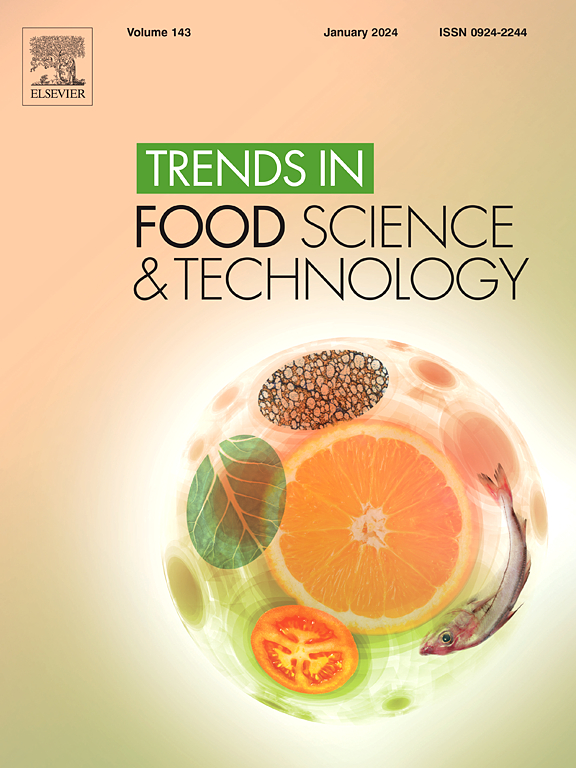人工智能算法辅助生物传感器在食源性致病菌检测中的应用:最新进展和未来趋势
IF 15.1
1区 农林科学
Q1 FOOD SCIENCE & TECHNOLOGY
引用次数: 0
摘要
检测食源性病原体是食品安全的一个关键方面,需要快速、准确和可靠的检测方法。尽管传统的生物传感技术已经取得了很大的进步,但它们在灵敏度、准确性和适应性方面仍然面临挑战,特别是在复杂的食物基质中。人工智能(AI)算法的集成,特别是机器学习(ML)和深度学习(DL)技术,在克服这些挑战和显着提高生物传感器性能方面显示出巨大的希望。本文综述了人工智能算法的应用,重点是ML和DL技术,以增强检测食源性病原体的生物传感器。它对不同的人工智能模型进行了比较分析,并建议使用适合各种生物传感器类型的算法,包括表面增强拉曼光谱(SERS)、荧光、比色和电化学生物传感器。本文还探讨了这些算法在食品安全中的实际应用和局限性,并概述了潜在的未来方向。结论ai算法辅助生物传感器显著提高了病原体检测的准确性和效率。这些算法使生物传感器能够实时处理复杂的多维数据,从而提高其在各种具有挑战性的食品样品中检测病原体的能力。尽管取得了显著的进步,但在算法适应和设备兼容性方面仍然存在挑战。这篇综述强调了人工智能辅助生物传感器在推进食品安全检测技术方面的变革潜力,重点是推动食品工业的未来创新和应用。本文章由计算机程序翻译,如有差异,请以英文原文为准。
Artificial intelligence algorithms-assisted biosensors in the detection of foodborne pathogenic bacteria: Recent advances and future trends
Background
Detecting foodborne pathogens is a critical aspect of food safety, requiring rapid, accurate, and reliable detection methods. Although conventional biosensing technologies have made significant progress, they still face challenges in sensitivity, accuracy, and adaptability, particularly in complex food matrices. The integration of artificial intelligence (AI) algorithms, particularly machine learning (ML) and deep learning (DL) techniques, shows great promise in overcoming these challenges and significantly enhancing biosensor performance.
Scope and approach
This review examines the application of AI algorithms, focusing on ML and DL techniques, to enhance biosensors for detecting foodborne pathogens. It presents a comparative analysis of different AI models and recommends using algorithms tailored to various biosensor types, including surface-enhanced Raman spectroscopy (SERS), fluorescence, colorimetric, and electrochemical biosensors. The paper also explores the practical applications and limitations of these algorithms in food safety and outlines potential future directions.
Key findings and conclusions
AI algorithms-assisted biosensors have significantly improved pathogen detection accuracy and efficiency. These algorithms allow biosensors to process complex multidimensional data in real-time, improving their ability to detect pathogens in diverse and challenging food samples. Despite notable advancements, challenges persist in algorithm adaptation and device compatibility. This review emphasizes the transformative potential of AI-assisted biosensors in advancing food safety detection technologies, focusing on driving future innovations and applications in the food industry.
求助全文
通过发布文献求助,成功后即可免费获取论文全文。
去求助
来源期刊

Trends in Food Science & Technology
工程技术-食品科技
CiteScore
32.50
自引率
2.60%
发文量
322
审稿时长
37 days
期刊介绍:
Trends in Food Science & Technology is a prestigious international journal that specializes in peer-reviewed articles covering the latest advancements in technology, food science, and human nutrition. It serves as a bridge between specialized primary journals and general trade magazines, providing readable and scientifically rigorous reviews and commentaries on current research developments and their potential applications in the food industry.
Unlike traditional journals, Trends in Food Science & Technology does not publish original research papers. Instead, it focuses on critical and comprehensive reviews to offer valuable insights for professionals in the field. By bringing together cutting-edge research and industry applications, this journal plays a vital role in disseminating knowledge and facilitating advancements in the food science and technology sector.
 求助内容:
求助内容: 应助结果提醒方式:
应助结果提醒方式:


